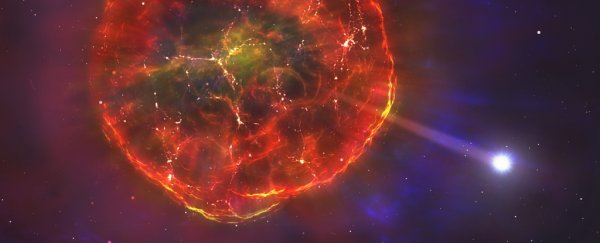A star discovered hurtling across the Milky Way is so bizarre that astronomers can only conclude it was ejected during a very unusual supernova event.
The star - a white dwarf around 1,430 light-years away called SDSS J1240+6710, and nicknamed Dox - is whizzing along at 250 kilometres per second (155 miles per second), against the direction of the galaxy's rotation. But that's not what's so weird about it.
Dox's chemical composition is extremely unusual - so unusual, it suggests that the star was kicked into high velocity by a type of supernova explosion we've never seen before.
White dwarfs are what's left when a low-mass star - up to around eight times the mass of the Sun - reaches the end of its lifespan, running out of material to fuse in its core.
Lone white dwarfs, like our Sun will be, will blow off most of their mass before the core collapses in on itself into an object less than around 1.4 solar masses. This is the maximum mass for a stable white dwarf.
These lone white dwarf stars won't go supernova - they'll just continue being white dwarfs, slowly cooling over billions of years. Their chemistry is fairly well understood, with most having atmospheres made up primarily of hydrogen and helium, along with a little bit of carbon and oxygen.
In 2015, however, astronomers discovered Dox, an unusually low-mass white dwarf star around 40 percent of the mass of the Sun. Spectroscopic analysis revealed that its atmosphere was almost pure oxygen, with traces of magnesium, neon, and silicon - not a trace of hydrogen or helium.
This obviously warranted a closer look, so a team of astronomers led by physicist Boris Gänsicke of the University of Warwick in the UK took spectroscopic observations of their own using the Hubble Space Telescope.
What they found was even more peculiar. Dox's atmosphere also contained traces of carbon, sodium, and aluminium. These elements are all produced during the initial thermonuclear reactions of a supernova explosion.
But heavier elements that are forged from these lighter elements during the later stages of a supernova - the 'iron group' elements, iron, nickel, chromium, and manganese - were also totally missing. As though the supernova started up, then died out.
When the team calculated the star's velocity, they discovered how rapidly it was whizzing across the galaxy, and the pieces fell into place.
"This star is unique because it has all the key features of a white dwarf but it has this very high velocity and unusual abundances that make no sense when combined with its low mass," Gänsicke explained.
"It has a chemical composition which is the fingerprint of nuclear burning, a low mass, and a very high velocity: all of these facts imply that it must have come from some kind of close binary system and it must have undergone thermonuclear ignition. It would have been a type of supernova, but of a kind that we haven't seen before."
Many stars in the Universe are in binary pairs, locked in a close mutual orbit, and this is how we can get a white dwarf supernova. If at least one of the stars is a white dwarf, and it siphons material off its companion star, it can accumulate too much material to remain stable, resulting in a supernova explosion.
The team believes that this process started, but the thermonuclear ignition and subsequent mass ejection was sufficient to disrupt the binary orbit, sending both stars flying off in opposite directions.
"If it was a tight binary and it underwent thermonuclear ignition, ejecting quite a lot of its mass, you have the conditions to produce a low mass white dwarf and have it fly away with its orbital velocity," Gänsicke said.
White dwarf binary supernovae are some of the most well-studied in the Universe. They are called Type Ia supernovae, and their well characterised absolute brightness makes them an incredibly useful tool for measuring cosmic distances.
They linger in the sky for some time, first brightening for a few months as the star explodes, then gradually fading over a few years. That residual light is powered by radioactive nickel - and the lack of it in Dox's failed kaboom could explain how we might have missed it.
The partial supernova would have just been a brief flash - an event that's easy to miss if we're not looking at it, and in this case, one that highlights how little we know about how stars die.
"We are now discovering that there are different types of white dwarf that survive supernovae under different conditions and using the compositions, masses, and velocities that they have, we can figure out what type of supernova they have undergone," Gänsicke said.
"There is clearly a whole zoo out there. Studying the survivors of supernovae in our Milky Way will help us to understand the myriads of supernovae that we see going off in other galaxies."
The research has been published in the Monthly Notices of the Royal Astronomical Society.
